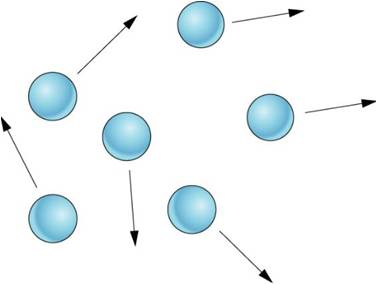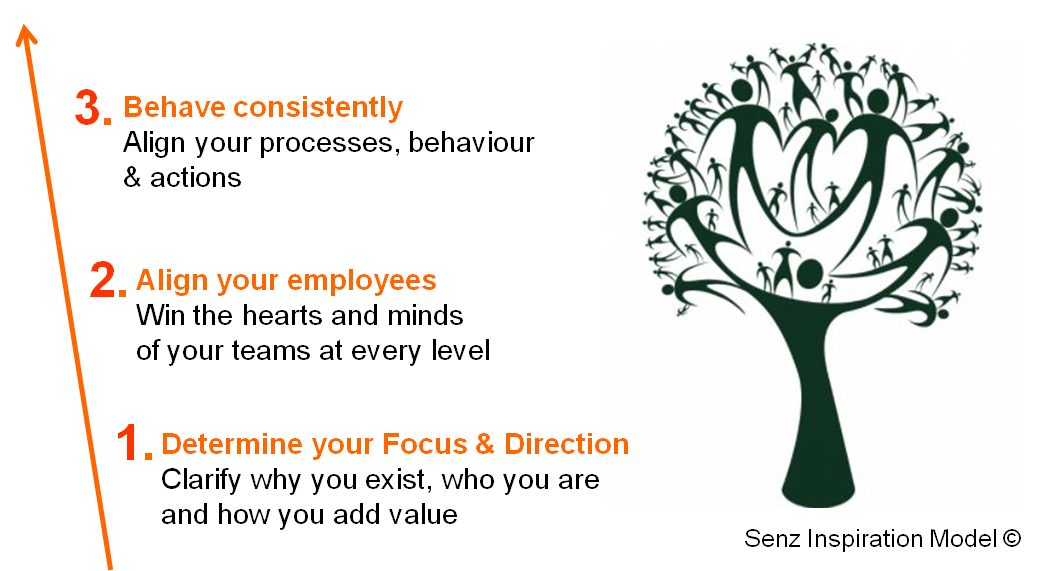- Home /
- employees
The 6 steps to drive successful organizational change
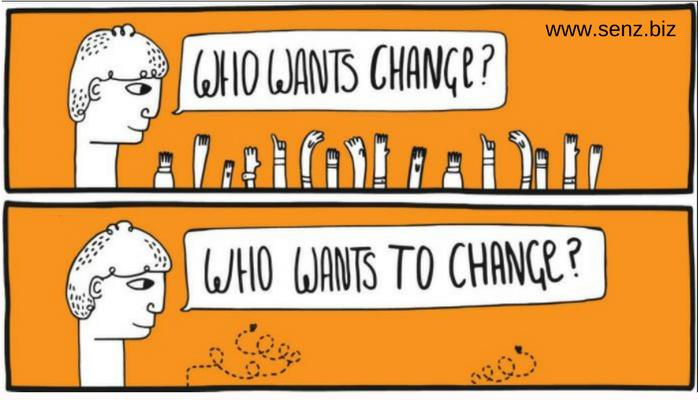
‘Our people are not heading into the same direction
Too many ad-hoc activities are going on
We expect more initiatives and commitment from our employees’
These are internal challenges many of my clients (in mid-sized and large organizations) are facing.
And that is not the only thing. Many external things are happening at the same time:
0 Unpredictable economy
0 Restrictive government regulations
0 Continuous increasing competition
This means that their market position and revenues are at stake and the team morale is lowering.
Mediocre companies cut budgets and initiatives, and lower prices.
A few excelling companies use ‘downtime’ to shake things up and choose for a ‘change management’ program to:
0 Boost the internal drive & productivity
0 Improve customer loyalty
0 Generate growth by new innovations
However, change management is not always that successful; 75% of the programs fail to reach their objectives.
Poorly managing change has many consequences, like:
0 Customers and other stakeholders begin to feel the negative impact
0 Productivity declines for a longer duration than necessary
0 Employee morale suffers and divisions between “us” and “them” begin to emerge in the organization
0 Stress, confusion and fatigue increase
0 Valued employees leave the organization
Each of these consequences can be addressed and mitigated if a project includes a structured approach to the people side of change.
Employee engagement is the critical component. If individuals don’t make changes to their day-to-day work, an organizational transformation effort will not deliver results. It does little good to create a new organization, design new work processes or implement new technologies if you leave the people behind.
Effective change management should follow the following principle:
Know why you exist, who you are and how you add value.
And live up to this in all you do, in all processes, in all materials and
in the behavior of your employees.
Dove is a lovely role model. They advocate that every woman is beautiful (WHY), Dove offers products that deliver superior care and make women feel beautiful (WHAT). And this is their HOW:
0 We always feature real women, never models
0 We portray women as they are in real life
0 We help girls build body confidence and self esteem
They apply this everywhere: in their packaging, advertising and in their Dove self-esteem project. This project helps young people develop a positive relationship with the way they look. They are highly successful.
So, be consistent in everything you do and say!
The Senz Biz Growth Model©, based on Mazlow’s theory of human needs, follows a structured process and uses a holistic set of tools to drive successful individual and organizational change.
The 6 steps to drive successful individual and organizational change
1. Establish Urgency
By defining a shared problem, the initial commitment to begin the change process is mobilized. Challenges trigger our survival mechanism and make us take action.
2. Build Powerful Coalitions
Support the change and remove the obstacles by using the input of frontrunners and criticasters. Belonging to a group is one of strongest human needs, which can be used to your benefit.
Read more: 7 strategies to turn passiveness into initiative
3. Create Direction
Turn on your source of inspiration by developing your WHY, WHAT and HOW. This creates a framework for your strategy, actions, leadership, structure and processes.
4. Lead by Example
Safety
Support the implementation of your strategy by creating a safe environment. Use the 5 essential factors that drive accountability and productivity in your team to develop and implement action plans.
Read more: 5 essential factors to get your team into action
5. Inspire Contribution
Recognition
Use the added value of each of your team members to create quick wins and build on the change. Research shows that productivity of teams improves by 50% if team members play the role that they are good at.
Read more: How to increase your team’s productivity by 50%
6. Make it stick
Survival
Create a supporting environment by aligning the processes, structure, skills, systems, leadership-style and staff recruitment to your identity.
Following these steps will help you:
0 Developing a framework to give direction to all activities
0 Creating systems, processes and measurements to improve the efficiency in your organization
0 Getting buy-in for the change from your employees at every level
Interested to see what Senz can mean to you and your business? Contact us today for a free strategy session.
With inspirational regards,
Karin van Zuilen
Senz – innovation & change management, www.senz.biz
p.s. Want more strategies to improve your team performance? Click here to get access to the 5 steps to improve your team performance
Are Visionary Leaders dying out?

Is visionary leadership for business gurus only? Or can it be for anyone running day-to-day business? Being visionary means creating and conveying an appealing sense of purpose. It is about winning the hearts and minds of your employees. This is something you can learn. In this article you read how.
In summary, this is what visionary leaders do:
Create a shared purpose. You cannot expect your team to be innovative and change if they do not know the direction in which they are headed. It is up to the leader to set the course and give a bearing for the future. You need to make sure that you can paint a clear picture, that it is concise, easy to understand and inspiring. This is the first step to win the hearts of your team.
Make it comfortable for their team to follow the new direction. Change is always uncomfortable. Your brain loves to follow the well known routes. This helps you greatly in daily life. For example, you will immediately pull away your hand when you coincidentally touch something really hot. However, your brain protests when you want to make a change. So, secondly, you need to make it easy for your team to follow your strategy. You need to win their heads, too
Let me share some more details.
4 MUST-DO’S to be a visionary leader
1 KNOW YOUR FACTS AND FIGURES
In order to create a vision, you first need to know where you are now. This means that you need to first gather baseline information. How?
– Talk with people at all levels of your organization. Ask: What do you think our current state is? How are we doing? What do we need?
– Closely observe your day-to-day business to identify what can be improved
– Collect all market insights & trends. What is currently happening in your market? What is the role & behavior of each of the stakeholders (competitors, buyers, influencers, government, etc.)? What about your own company’s role and behavior? What is happening?
– Collect and evaluate all financial information. Look at your performance and productivity markers.
– Take intentional actions to identify patterns and discover new opportunities, like studying other industries and attending events outside of your area of expertise.
Share your findings with your team to check your conclusions and get them engaged.
2 CREATE YOUR PURPOSE

Leaders who gather facts and figures develop a gut sense for critical long-term versus short-lived changes. Together with the answers to the following questions, those insights will assist in imaging what might be possible for your organization.
Consider your market and all players. And ask yourself:
– What is missing in this market? What is not fitting?
– What would you like to change, solve or complement?
– How can you solve the problems of your target group?
Once you have a basic vision, test it out on others. Ask early adopters and criticasters: ‘what could possibly go wrong with this thinking? What haven’t I thought about?’
Using this strategy, you can test out your vision and identify potential challenges while taking early strides toward gaining supporters.
3 COMMUNICATE WITH ENERGY AND COURAGE
If you want to inspire people to innovate, to change the way they do things and to achieve extraordinary results then you have to be passionate; passionate about what you believe in. You have to communicate that passion every time you speak.
The active support and participation of others can greatly accelerate your vision, while the lack of support can make even the best ideas irrelevant.
Focus on the things that you want to change, the most important challenges you face and be passionate about overcoming them. Your energy and drive will translate itself into direction and inspiration for your people.
4 PERSONIFY YOUR VISION.

Once your team is on board with (and fully understands) your vision and the steps necessary to get there, you must live everyday with intent to personify your vision.
Everything you do, even little things, should be done with the intent to execute your vision. In other words, BE the vision you want to see. This will significantly impact how your team works. They will begin to work with intent, too.
Along with practicing what you preach, it’s important to be an inspirer for your employees.
Want to learn more about how to establish this in your organization? Book a free strategy session.
By using the skills above, you can become a visionary leader.
Visionary leaders are the best to be and have because they can see the result long before it happens.
With visionary greetings,
Karin van Zuilen
Senz – innovation & change management, www.senz.biz
p.s. Want more strategies to improve your team performance? Click here to get access to the 5 steps to improve your team performance
5 essential factors to get your team into action

Brain Rule 4 for Teams – to make your team follow you
We do not trust our boss! In the corridor employees are complaining: ‘The direction of the company is not clear’, ‘we don’t believe what our manager says.’ Or ‘beautiful plans to build the brand, but the reality is very different.’ It may frustrate you that your employees don’t get it and don’t take the required action. Apply brain rule 4 to make your team trust and follow you.
The problem may be that a consistent message, that touches them, is missing. People need clarity and guidance. Probably, you remember the feeling that something is not right, if somebody tells you a lie. The first thing that happens is that your brain warns you that you are in danger. It starts producing a strain of counter-arguments.
Safety is one of the core needs. If insecurity and danger and therefore anxiety arise, this leads to action; but not in the right way. It leads to either fight or flight. Fight in this case means: working harder, or show that you are more important than others; and internal competition. Flight means: if they don’t see or hear me, nothing will happen. I just do my own thing and do not show myself.
Internal conflicts, stress and slowdown are the result. This unproductive process is going on in many companies. So, how can you deal with this as a leader?
Consistent messages that create a feeling of safety, inspire teams (and clients) to follow you. Subconscious counter-productive mechanisms in your brain will be over-ruled. Some leaders happen to be the ones that are followed by many people. They inspire their environment, so many team members feel the drive to perform. You can also make this happen!
Brain Rule 4 says: Establish a Safe Setting
This is important for clients, as well as for employees.
Read the 10 easy ways to make clients trust you and increase your credibility (and revenues).
These are the 5 essential factors how you can make your team trust you, and get into action.
1. Be the living example of your message! A big desire of employees is to have a role model, somebody to identify themselves with. However, if they receive different conflicting signals, people will get confused. Like in a company where the CEO told his team that customer orientation needs to be improved. Every day, he parked his car at the place for… clients! So, do what you pray!
2. Be consistent yourself; match your feeling, thinking and behavior. I remember a meeting where a manager jumped up with a red face and started to defend his point of view. One of the team members noticed: you seem to be very angry at us. He shouted: I am not angry. With denying your feelings, you may seem a rational leader, but you actually betray yourself; and others.
Other people immediately notice what is going on. This is due to your mirror-neurons in your brain. These are nerve-cells that notice and mirror the emotional state of mind of others. This means that your team members will immediately feel what you feel. So, realize what you really feel and think while you are sending a message. And be honest: do they match with each other?
3. Let your heart speak! This has an amazing effect! Without feeling, no passion. Without passion, no action. Managers need awareness of their own feelings as a precondition for effective leadership. This way, they will be perceived as authentic and trustworthy.
4. Listen to your team members. Recognition creates a safe environment and takes away 50% of all problems.
5. Send at least 7 consistent messages about the same topic (of course in a slightly different way). You may know that you need this to help prospects take action. However, the same is valid within your organization. You will immediately notice the effect.
Implement brain rule 4 and establish a safe setting for your team by speaking and acting from your heart. This makes them follow you and take action.
Do you know more ways? Share them in the comments.
With trustworthy greetings,
Karin
Senz – brand positioning & client attraction, www.senz.biz
p.s. Want more strategies to build a leading market position in the healthcare or services market? Click here to get access to our FREE resources with the newest marketing strategies and Senz & Brain Tips
7 strategies to turn negativity & passiveness into initiative
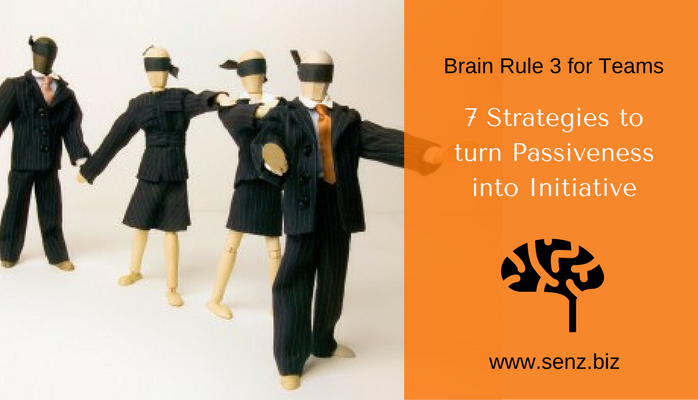
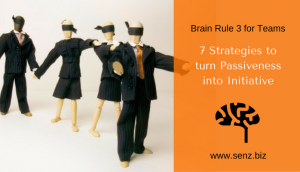
Brain Rule 3 for teams: to Increase the Initiative in your Team
Your employees are complaining that there is a lack of direction. They don’t feel motivated anymore.
Especially now, it’s important that they take initiative and do a better job than ever before.
Brain Rule 3 helps you get the initiative back in your team and increase the productivity.
As a leader you feel that your strategy is clear and you don’t understand why your employees don’t get it. Sales are lacking behind and something needs to happen. Otherwise, it is even necessary to start a re-organization and dismiss people.
You have tried a lot: you spoke with them, gave them clear assignments and maybe even a training. However, nothing really changed.
What is going on?
-Your employees really don’t know the direction. Leaders think that everybody knows it, but this is NOT the case. Research (CIPD) showed that out of 2000 employees only 29% knew the values and strategies of their company.
-It could well be that your team feels that the management goes into a direction they do not want to identify with
-Or maybe some of your team members know that they are nominated to be dismissed
-Or they feel that they are not valued anyhow
In all cases, this means that the connection between your employees and the company is lost. They do not feel that they belong to the company anymore (although they are employed).
You are not meeting one of the strongest forces in universe: ‘social belonging’. The importance of belonging to a group is not always immediately recognized. However, it has disastrous consequences for a company if this aspect is lacking. Our mental system is programmed to belong to a group. If this does not happen, our brain sends signals that feel like a punishment.
This leads to negativity, passivity, feelings of burn-out and demotivation. The loyalty to the company will drop with a negative impact on sick leave, employee turnover and productivity.
This can last for months and even years. No wonder that the clients feel this; with a negative effect on the bottom-line.
So, how can you get all noses into the same direction?
How can you make everybody feel responsible and take action?
How can you turn negativity & passiveness into initiative?
Restore the connection and make use of:
Brain Rule 3 for teams: create a sense of belonging
This is a proven recipe
Click here if you want to know how you can use brain rule 3 for clients.
7 strategies for leaders to turn negativity & passiveness into initiative:
1. Make clear what you stand for and what is your strategy
Communicate this message consistently and show it in actions. In the end, nobody wants to stay behind.
2. Be even clearer about what you expect of your employees.
Tell them what their added value is. Even in a period of re-organisation.
3. Create an enthusiastic (and big enough) group of pioneers, if you want to introduce new strategies.
Others will follow.
4. Mention the commonalities in your team and make clear where you are different than others.
People always prefer their own group above others.
5. Make clear to what group they belong if they take the wished actions.
Make also clear that you are also part of the group and lead by example.
6. Set concrete short-term objectives, so everybody can immediately notice the effect.
This way, you are positively influencing the intrinsic motivation, satisfaction and output. This does not work with abstract objectives that are too far away.
7. Give regular feed-back about the progress that has been made.
This way, people function in the best way (Amabile, Harvard University).
Do you know more strategies? Share them in the comments.
If you implement brain rule 3 in your team, you will immediately notice the impact on the productivity, teamwork and motivation. If this is lacking, this will lead to loads of stress, dissatisfaction and demotivation.
With connecting greetings,
Karin
p.s. Want more strategies to build a leading market position? Click here to get access to our FREE resources with the newest marketing strategies and Senz & Brain Tips
Brain Rule 2 – how to increase your team’s productivity by 50%
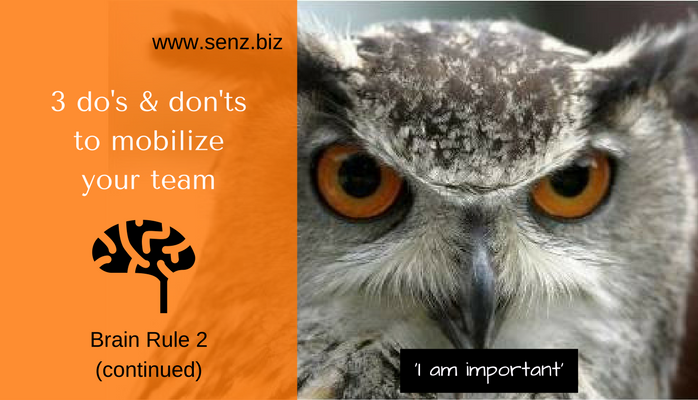
To Increase your Team’s Productivity
How can your clients be inspired if your employees aren’t inspired? This is the question, I have asked many teams. This has also been researched thoroughly. It can be concluded that the productivity and profit of teams can be increased by 50% if brain rule 2 has been applied.
What if your clients are not being treated like a king by your team-members?
What if your employees don’t love their company and their role?
What if your team is perceived differently than you aim for?
You are positioned as this service oriented, fast and kind company. However, if there is a complaint… your customer service employee does not listen and even becomes angry. Your business development manager makes promises he cannot make come true. And you are not able to deliver your products in time. This ruins the company!
You may know this story. I love it!
One day, Bob, the CEO of a hospital, was walking down the hallway. He came across a singing cleaning lady working. He stopped to talk with her for a few moments and eventually he asked the lady what she did.
The cleaner stopped, turned to Bob with a completely serious look and replied, “I save lives”. Bob was taken aback. What was this lady talking about? She’s the cleaner, not a heart surgeon.
She continued, “See, when I do my job well and clean the operating rooms and other work areas, the doctors have a sanitary, safe place to do their jobs. I clean things, yes, but in the bigger scheme of things, I’m helping to save lives”. Bob, the CEO instantly realized his own “small thinking” and saw that the cleaner had a view of the mission of the hospital from an entirely different, yet valuable, perspective.
This means that brain rule 1 (share WHY you exist, your higher goal) is in place. This lady is fully committed to the higher goal of the hospital.
Also brain rule 2 (value & recognize your clients & employees) has been implemented. Her self esteem is high, she feels valuable. This makes a big difference. Do you think that this lady will clean the hospital better or somebody who feels demotivated?
For the ones who like numbers, did you know that:
– The productivity of teams increases with 50% if each team member fulfills the role they are good at. In a car factory, 2 teams were selected. Each team member listed their qualities. These were shared with everybody. Then, they got the tasks matching their qualities. 6 month later, the productivity of these 2 teams has improved by 50% versus the unchanged teams.
– Productivity and profit increase in more inspired companies. A study under 8000 business-units of 36 companies in US measured the inspiration versus the profit of the company. Both productivity (+80-120.000 dollar per month) and profit (+1-4%) were higher in the more inspired companies.
Brain Rule 2: Value & recognize your clients & employees
Let’s take a look at what the 3 do’s and don’ts are
to increase the inspiration & productivity of your team.
1. Listen openly to your team-members’ ideas
Don’t: Ask for their opinion and never get back to it, or tell them they are wrong. They will never open up to you again.
Do: Take their ideas seriously & see how they can complement your own ideas. Give them feedback.
Easy Win: Ask a few of your team-members what is the most important hurdle to get more clients. Listen to them and acknowledge them for being that honest. Adjust your strategies and messages accordingly. Otherwise, their brain will protest and they will sabotage your plans.
2. Make sure all team-members know and feel the added value of the team
Don’t: Think and show that your team is not important or capable. It will be a self-fulfilling prophecy.
Do: Keep the spirit high by sharing the importance of what you are doing. Everybody in your team should know what the company & clients miss if you wouldn’t be around.
Easy Win: Share in every assignment that you dedicate to your team (yes, also in your e-mails) why this is relevant to the company’s success.
3. Make sure that you recognize the added value of each team-member
Don’t: Chase your team-members on things they are not able to do. It will be both frustrating for you and them.
Do: Recognize the strength of each of the team-members. Make sure everybody knows about it. Make use of the feeling of being a winner.
Easy Win: Let you team members list their qualities. Share them with the rest of the team. Then, give them tasks that match their qualities. If you need somebody to make a presentation, ask the one who is good at this. If you need a spreadsheet with numbers, ask the one who really likes this. You will be amazed what will happen!
If you implement the winners’ mentality in your team, the productivity will quickly improve. Yes, I know, there are always other priorities: your daily activities, the report to the board, the launch of a new product. However, don’t forget: an inspired team can do 50% more. What is a better investment?
You can read here how to use this Brain Rule to engage your customers.
Any other inspirational tips for teams? Share them at the comments section.
With teamwork greetings,
Karin


